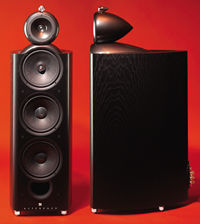Hey Guys,
I'm not sure if the DIY forum is the appropriate place for this post, but it seemed like a person who knows how to design/build a crossover would be excellent at troubleshooting one This is, after all, still a DIY project.
This is, after all, still a DIY project.
About 6 months ago I picked up a used set of KEF 207 series reference speakers. At the time of purchase the speakers were both functioning perfectly. About a week ago, I sat down and flipped the system on, only to find that it sounded very different than usual. Upon further inspection, I determined that two of the six drivers in the left speaker were no longer functioning. At first I expected that the drivers themselves were the culprits, but after bypassing the crossovers I found that the drivers seemed to function normally. I've narrowed down the problem to the crossover network using a voltmeter. The input signal to the PCB is fine, but the output to the speakers is VERY small (barely even shows up on a volt meter and does not produce an audible sound through the driver).
Here is a pic of the actual speaker:

The drivers in question are the very top silver super HF tweeter, and the top 10" mid-range woofer. The inputs on the back of the speaker are separated into three sets of posts. The lowest set of posts drive the lower two 10" woofers, the middle set of posts drive the upper 10"woofer and the outer gray portion of the 6" driver, and the upper set of posts drive the center silver section of the 6" driver and the small silver stand alone tweeter on the very top. There is also a set of plugs that adjust the tonal balance of the speakers built into the input plate. Here is a picture to help explain what I am talking about:

A pic of the crossover:

I have no idea what might have caused the damage to the crossover. I do, however, have a roommate (who swears he doesn't know anything about it) so who knows.. Can anyone give me some pointers on how to go about troubleshooting this crossover? The "crossover" appears to actually be three separate crossovers (One for each set of posts). I found it interesting that half of the drivers on the HF board work, and half of the drivers on the mid-range board work. It seems more logical that one entire board would fail. Assuming I can determine the faulty component, I have absolutely no qualms about replacing parts on the pcb.
Also, I've posted low res cellphone pics in the thread for general purposes. If anyone needs high res pics, just let me know.
Thanks,
Craig Rhyne
I'm not sure if the DIY forum is the appropriate place for this post, but it seemed like a person who knows how to design/build a crossover would be excellent at troubleshooting one
 This is, after all, still a DIY project.
This is, after all, still a DIY project.About 6 months ago I picked up a used set of KEF 207 series reference speakers. At the time of purchase the speakers were both functioning perfectly. About a week ago, I sat down and flipped the system on, only to find that it sounded very different than usual. Upon further inspection, I determined that two of the six drivers in the left speaker were no longer functioning. At first I expected that the drivers themselves were the culprits, but after bypassing the crossovers I found that the drivers seemed to function normally. I've narrowed down the problem to the crossover network using a voltmeter. The input signal to the PCB is fine, but the output to the speakers is VERY small (barely even shows up on a volt meter and does not produce an audible sound through the driver).
Here is a pic of the actual speaker:
The drivers in question are the very top silver super HF tweeter, and the top 10" mid-range woofer. The inputs on the back of the speaker are separated into three sets of posts. The lowest set of posts drive the lower two 10" woofers, the middle set of posts drive the upper 10"woofer and the outer gray portion of the 6" driver, and the upper set of posts drive the center silver section of the 6" driver and the small silver stand alone tweeter on the very top. There is also a set of plugs that adjust the tonal balance of the speakers built into the input plate. Here is a picture to help explain what I am talking about:
A pic of the crossover:
I have no idea what might have caused the damage to the crossover. I do, however, have a roommate (who swears he doesn't know anything about it) so who knows.. Can anyone give me some pointers on how to go about troubleshooting this crossover? The "crossover" appears to actually be three separate crossovers (One for each set of posts). I found it interesting that half of the drivers on the HF board work, and half of the drivers on the mid-range board work. It seems more logical that one entire board would fail. Assuming I can determine the faulty component, I have absolutely no qualms about replacing parts on the pcb.
Also, I've posted low res cellphone pics in the thread for general purposes. If anyone needs high res pics, just let me know.
Thanks,
Craig Rhyne

 According to John Atkinson at Stereophile they both sound and measure nicely. :P
According to John Atkinson at Stereophile they both sound and measure nicely. :P 
Comment